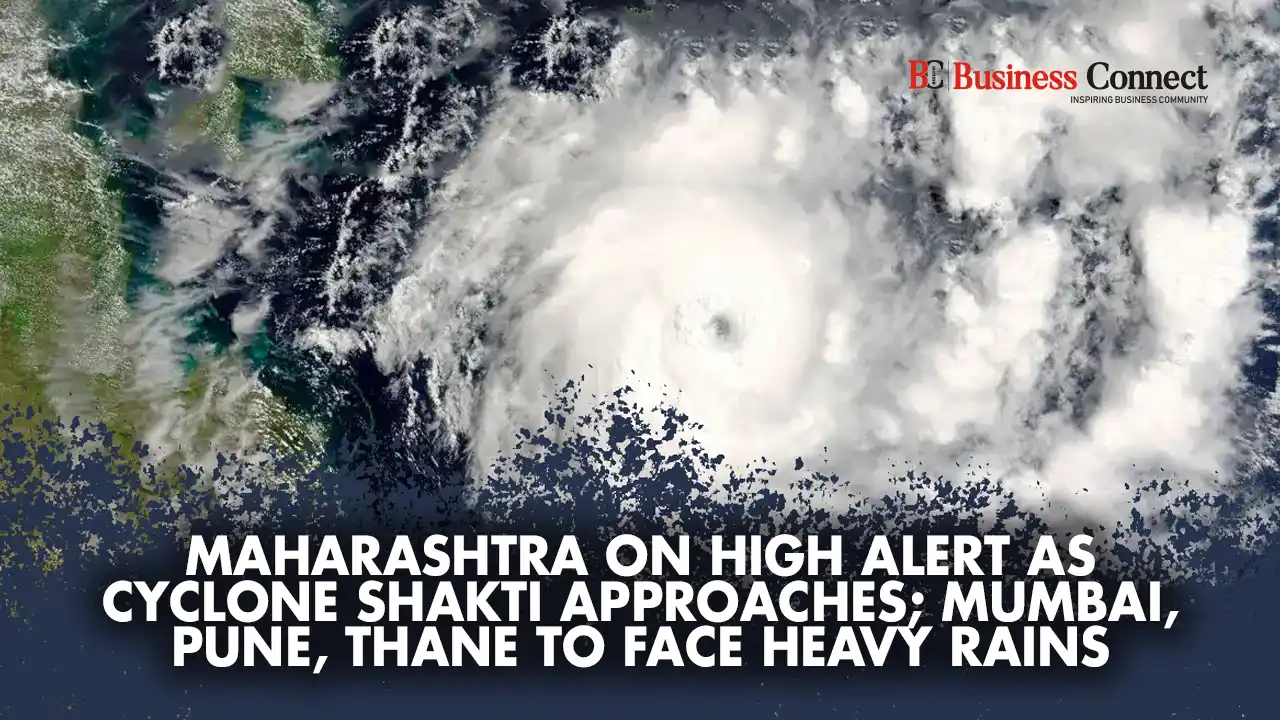Introduction:
Cyclone Shakti is the first major cyclonic storm of the 2025 post-monsoon season in the Arabian Sea. It formed in early October 2025 and has drawn widespread attention due to its potential to bring heavy rains, strong winds, and coastal disturbances to Maharashtra. Although the India Meteorological Department (IMD) has stated that the cyclone may not make a direct landfall on the state’s coast, its indirect effects are expected to be significant. The storm highlights how climate patterns over the Arabian Sea are changing and how coastal states like Maharashtra must remain prepared for extreme weather events.

Formation and Development:
Cyclone Shakti began as a low-pressure system over the central Arabian Sea in late September 2025. Warm sea surface temperatures and favorable wind patterns allowed it to intensify into a depression and later into a cyclonic storm. As it moved northwestward, the storm gathered strength and was officially named Shakti by the IMD.
The name “Shakti,” meaning “power” or “energy” in Sanskrit, was suggested by one of the member countries of the World Meteorological Organization’s cyclone naming committee. It symbolizes the immense natural force of such storms and the potential danger they can bring to human settlements and the environment.
Meteorological Characteristics:http://cyclone shakti
According to IMD reports, Cyclone Shakti intensified into a severe cyclonic storm by early October. The storm’s core winds reached speeds of 90–100 km/h, with gusts touching 110 km/h in its central region. While the cyclone remained largely over the sea, its outer rainbands extended toward India’s west coast, especially Maharashtra and Gujarat.
The storm’s movement was initially west-southwestward, but by October 5, it began curving northeastward under changing atmospheric conditions. This shift reduced the chances of a direct landfall on the Maharashtra coastline but did not eliminate the risks of heavy rainfall, coastal flooding, and rough seas. The IMD warned of very rough to extremely rough sea conditions along the Konkan coast, prompting strict advisories for fishermen to stay ashore.
IMD Alerts and Warnings:
The IMD issued orange and yellow alerts for several districts in Maharashtra between October 3 and October 7. Coastal areas such as Mumbai, Thane, Palghar, Raigad, Ratnagiri, and Sindhudurg were expected to experience heavy to very heavy rainfall accompanied by strong winds. Inland districts like Pune, Nashik, Marathwada, and Vidarbha were also forecast to receive moderate to heavy showers due to moisture incursion from the cyclone.
Impact on Maharashtra:
1. Heavy Rainfall and Flooding:
Cyclone Shakti brought widespread rainfall across Maharashtra. Cities like Mumbai, Thane, and Pune recorded intense downpours that led to localized flooding and traffic disruptions. In the Konkan region, heavy rains triggered waterlogging, uprooted trees, and affected power lines. The hilly areas of Ratnagiri and Sindhudurg faced risks of landslides due to saturated soil.
2. Strong Winds and Coastal Damage:
Strong gusty winds along the coast damaged temporary structures, hoardings, and tin roofs. Fishing boats anchored near the shore faced the risk of being overturned due to high waves. Ports in Mumbai, Ratnagiri, and Raigad suspended marine operations temporarily as a precautionary measure.
3. Transport and Power Disruptions:
The heavy rains caused waterlogging on roads and railway tracks, leading to delays in suburban train services in Mumbai and surrounding regions. Air traffic experienced temporary suspensions due to poor visibility and gusty winds. Power cuts were reported in several localities as a safety measure to prevent short circuits during heavy rains.

Government and Disaster Management Response:
The Maharashtra State Disaster Management Authority (MSDMA), in coordination with local administrations and the National Disaster Response Force (NDRF), began implementing precautionary measures days before the cyclone’s approach. Evacuation plans were prepared for vulnerable coastal areas. Relief materials such as food, water, and medical supplies were pre-stocked in district warehouses.
The coordination between the IMD, state authorities, and local civic bodies demonstrated the importance of timely communication and preparedness in managing natural disasters.
Public Awareness and Safety Measures:
The state government and various civic agencies launched awareness campaigns on television, radio, and social media platforms. Citizens were advised to stay indoors during intense rainfall, avoid waterlogged roads, and keep emergency contact numbers handy. People living in informal settlements near creeks or low-lying zones were encouraged to move to safer shelters provided by local authorities.
Environmental and Economic Implications:
Cyclone Shakti underscores the growing vulnerability of India’s western coast to extreme weather events. Warmer ocean temperatures due to climate change are fueling more frequent and intense cyclones in the Arabian Sea. Maharashtra, once relatively shielded from such systems, is now witnessing stronger post-monsoon disturbances.
Economically, the storm disrupted agriculture, fishing, and small coastal businesses. The fishing community suffered temporary losses as marine activities were suspended. Agricultural losses in Marathwada and Vidarbha could impact local economies already strained by erratic rainfall patterns.
Environmentally, cyclones can lead to soil erosion, destruction of mangroves, and salinization of coastal lands. On the positive side, the rainfall helped recharge reservoirs and groundwater levels in drought-prone regions.
Lessons Learned and Future Preparedness:
Cyclone Shakti serves as a reminder that early preparedness and strong communication systems are key to disaster mitigation. Maharashtra’s experience with recent storms like Nisarga (2020) and Tauktae (2021) has improved its capacity to respond effectively. However, continuous investment in climate-resilient infrastructure—such as upgraded drainage systems, stronger embankments, and efficient evacuation shelters—remains essential.
Conclusion:
Cyclone Shakti has once again shown how nature’s immense power can test human preparedness. While Maharashtra managed to avoid the cyclone’s direct impact, the state still experienced widespread rain, strong winds, and disruptions. The coordinated efforts of the IMD, disaster response teams, and local administrations helped minimize the damage and ensured public safety.
As climate change continues to influence weather systems, Maharashtra and other coastal states must remain vigilant. Building resilient cities, protecting natural coastal barriers, and fostering public awareness are the best ways to ensure that future cyclones cause minimal harm.

